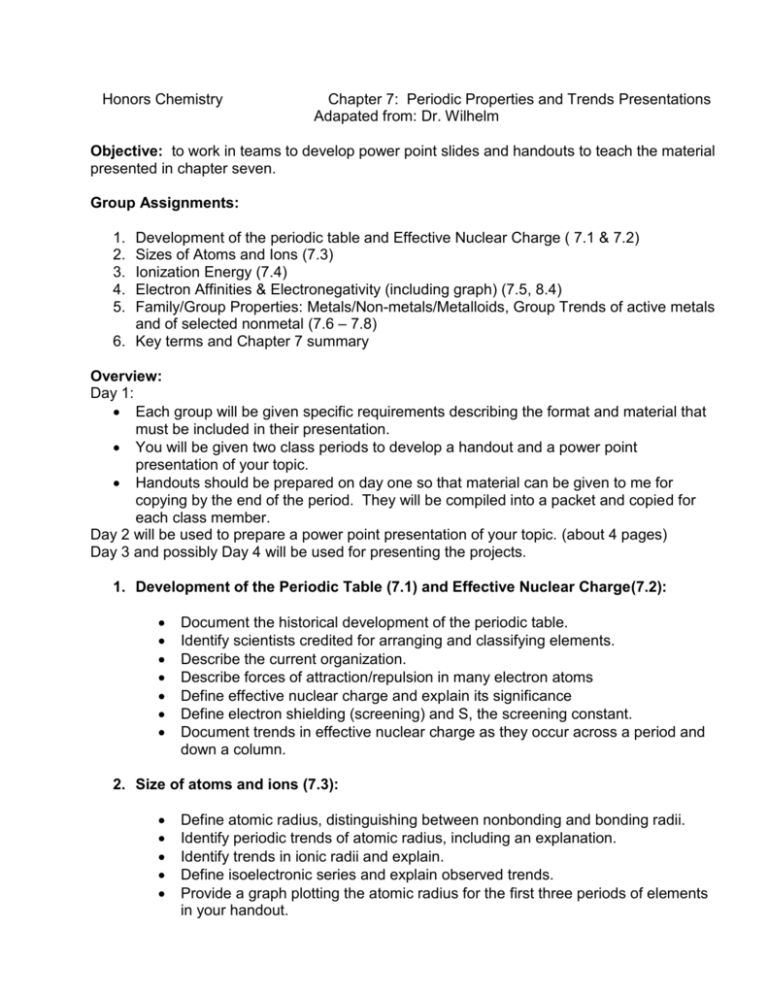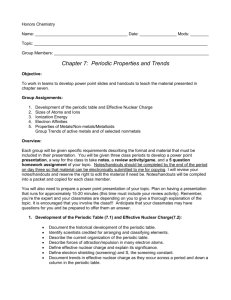c7-activityoutline
advertisement

Honors Chemistry Chapter 7: Periodic Properties and Trends Presentations Adapated from: Dr. Wilhelm Objective: to work in teams to develop power point slides and handouts to teach the material presented in chapter seven. Group Assignments: 1. 2. 3. 4. 5. Development of the periodic table and Effective Nuclear Charge ( 7.1 & 7.2) Sizes of Atoms and Ions (7.3) Ionization Energy (7.4) Electron Affinities & Electronegativity (including graph) (7.5, 8.4) Family/Group Properties: Metals/Non-metals/Metalloids, Group Trends of active metals and of selected nonmetal (7.6 – 7.8) 6. Key terms and Chapter 7 summary Overview: Day 1: Each group will be given specific requirements describing the format and material that must be included in their presentation. You will be given two class periods to develop a handout and a power point presentation of your topic. Handouts should be prepared on day one so that material can be given to me for copying by the end of the period. They will be compiled into a packet and copied for each class member. Day 2 will be used to prepare a power point presentation of your topic. (about 4 pages) Day 3 and possibly Day 4 will be used for presenting the projects. 1. Development of the Periodic Table (7.1) and Effective Nuclear Charge(7.2): Document the historical development of the periodic table. Identify scientists credited for arranging and classifying elements. Describe the current organization. Describe forces of attraction/repulsion in many electron atoms Define effective nuclear charge and explain its significance Define electron shielding (screening) and S, the screening constant. Document trends in effective nuclear charge as they occur across a period and down a column. 2. Size of atoms and ions (7.3): Define atomic radius, distinguishing between nonbonding and bonding radii. Identify periodic trends of atomic radius, including an explanation. Identify trends in ionic radii and explain. Define isoelectronic series and explain observed trends. Provide a graph plotting the atomic radius for the first three periods of elements in your handout. 3. Ionization Energy (7.4) Define ionization energy Distinguish between 1st and 2nd ionization energy. Identify periodic trends for 1st ionization energy. Highlight at least one irregularly to trend and explain. Describe electron configuration of ions. Provide graph plotting 1st ionization energy for the first three periods of elements on the periodic table. 4. Electron Affinities/Electronegativity (7.5 & pg. 312) Define electron affinity and distinguish its differences from ionization energy. Explain the trends for electron affinity Define electronegativity and relate it to electron affinity. Plot graphs for electronegativity and electron affinity for the first three periods of the periodic table. 5. Properties of Metals/non-metals/metalloids (7.6-7.8) Group Trends of active metals and selected nonmetals Define properties of metals and relate to periodic trends. Describe ionic compounds and properties of metal oxides. Define properties of nonmetals and relate to periodic trends. Define properties f metalloids and give several examples. Define property, trends and applications of alkali metals. Define property, trends and applications of alkaline earth metals. Define property, trends and applications of selected nonmetals, including hydrogen, oxygen, halogens and noble gases. 6. Key terms and Periodic Table Trends Summary/Highlights List and define key terms for Chapter 7 Summarize periodic table trends and Summarize key concepts from Chapter 7





